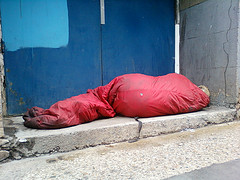
If you truly want to help a person who is sleeping rough, you can’t just provide housing and then walk away, writes Edward Santow.
Commentary
Two
years ago, the Federal Government set the goal of halving homelessness by 2020.
State and federal governments have committed billions of dollars, but without a
clear plan to address homelessness in all its maddening complexity, the goal has
looked unachievable.
Recently,
however, there have been some positive signs. The Federal Government has just
allocated $5 million to fund new research to understand the complex set of
factors that lead to homelessness, and develop policy accordingly. The researchers
will do this by following the lives of about 1500 people, interviewing them
every six months over two years.
This
new funding seems to indicate a growing awareness that service delivery in this
area, while well-intentioned, has not been well coordinated, nor has it
properly responded to the needs of homeless people.
If
you truly want to help a person who is sleeping rough, you can’t just provide
housing and then walk away. It might seem obvious, but policy often ignores the
root causes of homelessness, including mental illness and persistent legal
problems. Without confronting these, the housing solution often won’t take
hold.
The
Homeless Persons’ Legal Service (HPLS) is a successful project that brings
together a number of NGOs, as well as Legal Aid NSW and several corporate law
firms. It aims to address one of the underlying causes of homelessness. The
fact that HPLS lawyers provided over 800 free advices last year shows the scale
of the legal problems facing people who are homeless.
However,
the experience of Brendan, an HPLS client, exemplifies some of the complexity
in addressing homelessness.
Brendan grew up from an early age witnessing severe
emotional and domestic abuse. His escape from a dysfunctional home landed him
on the streets and contributed to his developing severe drug dependency.
After
a three-year wait, Brendan was finally given public housing. However, he had no
safe conception of ‘home’ and lacked many skills needed to sustain a tenancy.
Three months later, Brendan was back on the street and again using drugs.
Enormous
effort and resources went into providing Brendan with a home. But, with
insufficient attention given to the underlying causes of his homelessness, he
was set up to fail.
A
doctor who prescribed throat lozenges to address a cancer patient’s cough,
without treating the disease itself, would be derelict in their duty. Similarly,
in framing policy to combat homelessness, we need to acknowledge that not
having a home is frequently a symptom rather than the disease.
Most
tragically, the lives of people experiencing homelessness are often marked by
violence. Drawing on the HPLS experience, the Public Interest Advocacy Centre
commissioned Dr Catherine Robinson to explore how violence can cause someone to
lose their home, and how violence can continue on the street.
Her
report, Rough Living, quoted Marty, a woman who left home when
she was just eight. Marty said: When it was just my mum and dad at home there
was physical violence, like he was beating her up and my brothers and I saw
that. There was also sexual abuse
on my part you know like men coming into the room and touching.
Such
experiences contribute to often debilitating trauma. Unless support services
provide more holistic care for those experiencing homelessness, the underlying
trauma will continue to fester and increase the likelihood of a relapse into
homelessness.
This
trauma is exacerbated when homeless people are denied equal protection under
the law. The HPLS recently heard the following all-too-common account from one
rough sleeper.
Early one morning, my friend and I were woken by a ‘size-12
alarm clock’. For some reason
three guys who had a few too many decided they would attack a couple of
‘streeties’ and me and my mate were the first that they came across. They kicked and punched us so hard that
they put us both in hospital. When we reported the attack to the police they
said ‘well you live on the street, what did you expect?’
Australians
have opened their hearts (and wallets) to victims of the devastating floods in
Queensland. When we see footage of a family’s home being swept away by a flood,
we easily appreciate that they’re not responsible for their misfortune.
Similarly,
through no personal fault, one can easily become homeless as a result of mental
illness. This causal link is well known, and so governments and civil society
must do more to support programs that address such related problems together.
The
urge to lend a hand to those less fortunate is a wonderful Australian trait. Sensing
this, both major parties have shown leadership in starting to combat
homelessness. Those good intentions now need to be directed towards clever
policies that address homelessness at its source.
Names in
this article have been changed. Edward Santow is chief executive of the Public
Interest Advocacy Centre.
Photo: Flickr